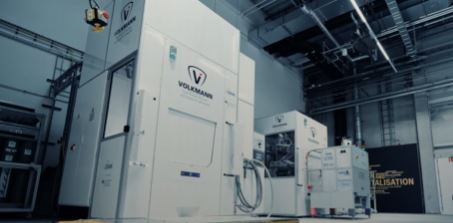
BMW, GKN Additive Manufacturing, and Volkmann Drive 3D Printing Research
Three, Key Lessons Learned in Metal Powder Transfer and Recovery
3D printing companies and others driving the rise of additive manufacturing have been quietly investing huge amounts of resources into learning about the 3D printing process and fine-tuning it to produce better quality metal parts more efficiently and at less cost. A number of key players in AM have been researching, developing and testing a wide variety of materials and equipment to build a knowledge base of metal powder properties, quality control standards, part testing and inspection guidelines, and best practices.
BMW Group, the global car manufacturer, and GKN Additive, the global additive manufacturing arm of GKN Powder Metallurgy, joined Volkmann, and several other companies offering a high level of engineering expertise, in a unique project designed to create the technology needed to advance metallic 3D printing to the point where it can be integrated into conventional production lines and expedite the manufacturing process. It’s called IDAM, the “Industrialization and Digitization of Additive Manufacturing (AM) for Automotive Series Processes” and it’s been in continuous action since March 27, 2019.
Four years later, we’ve all learned a lot about metal part manufacturing using 3D printing. Here are three of the key lessons:
It’s proven that nearly the entire production process for 3D printing can be automated from start to finish. Layering and building the metal part had been envisioned as an automated process from the outset. But now it’s understood that consistently producing high quality, 3D printed metal parts requires automating as many ancillary steps as possible to safeguard the metal powders from contamination and to safeguard workers from toxic exposure. This means automatically transferring metal powders from storage containers, removing unused metal powders from the build chamber, and performing secondary finishing tasks like deburring and cleaning. Manual tasks like powder handling that put both workers and powdered materials at risk can be eliminated.
We’ve also proven that even minimal amounts of moisture can negatively affect the metal powder and alter its properties. This requires the humidity level in the facility to be carefully monitored and metal powders to be sealed off from the plant environment during storage and transfer to the printer. Otherwise, the once fine particles can agglomerate into small clumps that don’t flow well during transfer and cause imperfections like pores and burrs if allowed to flow through to the printer. To maintain metal powder quality even in changing environmental conditions, Volkmann GmbH has developed an inline vacuum dryer that automatically removes the excess moisture and returns the materials to the correct moisture content. This powder drying system can be used to dry virgin materials fresh from the metal powder supplier and to prepare excess or unused material for reuse.
Given our commitment to recycling, waste reduction, and efficiency, we’re very proud to have developed the ability to automatically extract unused metal material from the build chamber, screen it for agglomerates, dry it, and return the on-spec powders to the printing process or to storage for reuse. We’re even merging recycled and virgin material in different ratios depending on the printed metal part to further promote material reuse. This sustainability innovation alone can save huge amounts of money in material costs.
Four years ago, we could not have anticipated all of the engineering achievements that would result from our work as an IDAM partner, especially in an industry evolving as rapidly as additive manufacturing. But the lessons we’ve learned and the knowledge we’ve shared with other AM manufacturing leaders are proving essential to advancing the growth of 3D printing as a viable process worldwide.
You can see our latest achievements at RAPID + TCT and Formnext: the PowTReX metal powder transfer and recovery system and DPS automated depowdering station – learn more here.